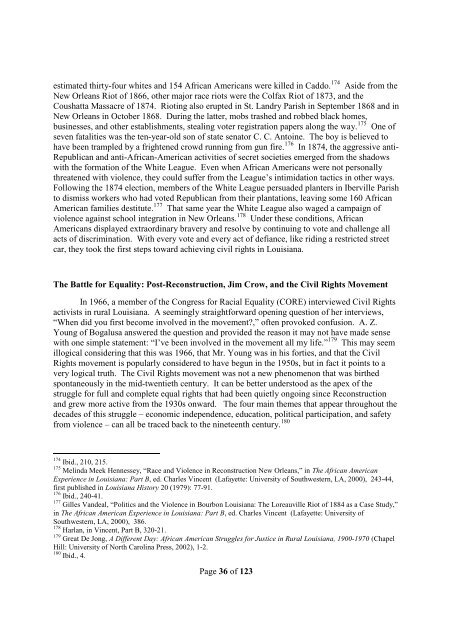The African American Experience in Louisiana
The_African_American_Experience_in_Louisiana
The_African_American_Experience_in_Louisiana
- No tags were found...
Create successful ePaper yourself
Turn your PDF publications into a flip-book with our unique Google optimized e-Paper software.
estimated thirty-four whites and 154 <strong>African</strong> <strong>American</strong>s were killed <strong>in</strong> Caddo. 174 Aside from the<br />
New Orleans Riot of 1866, other major race riots were the Colfax Riot of 1873, and the<br />
Coushatta Massacre of 1874. Riot<strong>in</strong>g also erupted <strong>in</strong> St. Landry Parish <strong>in</strong> September 1868 and <strong>in</strong><br />
New Orleans <strong>in</strong> October 1868. Dur<strong>in</strong>g the latter, mobs trashed and robbed black homes,<br />
bus<strong>in</strong>esses, and other establishments, steal<strong>in</strong>g voter registration papers along the way. 175 One of<br />
seven fatalities was the ten-year-old son of state senator C. C. Anto<strong>in</strong>e. <strong>The</strong> boy is believed to<br />
have been trampled by a frightened crowd runn<strong>in</strong>g from gun fire. 176 In 1874, the aggressive anti-<br />
Republican and anti-<strong>African</strong>-<strong>American</strong> activities of secret societies emerged from the shadows<br />
with the formation of the White League. Even when <strong>African</strong> <strong>American</strong>s were not personally<br />
threatened with violence, they could suffer from the League’s <strong>in</strong>timidation tactics <strong>in</strong> other ways.<br />
Follow<strong>in</strong>g the 1874 election, members of the White League persuaded planters <strong>in</strong> Iberville Parish<br />
to dismiss workers who had voted Republican from their plantations, leav<strong>in</strong>g some 160 <strong>African</strong><br />
<strong>American</strong> families destitute. 177 That same year the White League also waged a campaign of<br />
violence aga<strong>in</strong>st school <strong>in</strong>tegration <strong>in</strong> New Orleans. 178 Under these conditions, <strong>African</strong><br />
<strong>American</strong>s displayed extraord<strong>in</strong>ary bravery and resolve by cont<strong>in</strong>u<strong>in</strong>g to vote and challenge all<br />
acts of discrim<strong>in</strong>ation. With every vote and every act of defiance, like rid<strong>in</strong>g a restricted street<br />
car, they took the first steps toward achiev<strong>in</strong>g civil rights <strong>in</strong> <strong>Louisiana</strong>.<br />
<strong>The</strong> Battle for Equality: Post-Reconstruction, Jim Crow, and the Civil Rights Movement<br />
In 1966, a member of the Congress for Racial Equality (CORE) <strong>in</strong>terviewed Civil Rights<br />
activists <strong>in</strong> rural <strong>Louisiana</strong>. A seem<strong>in</strong>gly straightforward open<strong>in</strong>g question of her <strong>in</strong>terviews,<br />
“When did you first become <strong>in</strong>volved <strong>in</strong> the movement?,” often provoked confusion. A. Z.<br />
Young of Bogalusa answered the question and provided the reason it may not have made sense<br />
with one simple statement: “I’ve been <strong>in</strong>volved <strong>in</strong> the movement all my life.” 179 This may seem<br />
illogical consider<strong>in</strong>g that this was 1966, that Mr. Young was <strong>in</strong> his forties, and that the Civil<br />
Rights movement is popularly considered to have begun <strong>in</strong> the 1950s, but <strong>in</strong> fact it po<strong>in</strong>ts to a<br />
very logical truth. <strong>The</strong> Civil Rights movement was not a new phenomenon that was birthed<br />
spontaneously <strong>in</strong> the mid-twentieth century. It can be better understood as the apex of the<br />
struggle for full and complete equal rights that had been quietly ongo<strong>in</strong>g s<strong>in</strong>ce Reconstruction<br />
and grew more active from the 1930s onward. <strong>The</strong> four ma<strong>in</strong> themes that appear throughout the<br />
decades of this struggle – economic <strong>in</strong>dependence, education, political participation, and safety<br />
from violence – can all be traced back to the n<strong>in</strong>eteenth century. 180<br />
174 Ibid., 210, 215.<br />
175 Mel<strong>in</strong>da Meek Hennessey, “Race and Violence <strong>in</strong> Reconstruction New Orleans,” <strong>in</strong> <strong>The</strong> <strong>African</strong> <strong>American</strong><br />
<strong>Experience</strong> <strong>in</strong> <strong>Louisiana</strong>: Part B, ed. Charles V<strong>in</strong>cent (Lafayette: University of Southwestern, LA, 2000), 243-44,<br />
first published <strong>in</strong> <strong>Louisiana</strong> History 20 (1979): 77-91.<br />
176 Ibid., 240-41.<br />
177 Gilles Vandeal, “Politics and the Violence <strong>in</strong> Bourbon <strong>Louisiana</strong>: <strong>The</strong> Loreauville Riot of 1884 as a Case Study,”<br />
<strong>in</strong> <strong>The</strong> <strong>African</strong> <strong>American</strong> <strong>Experience</strong> <strong>in</strong> <strong>Louisiana</strong>: Part B, ed. Charles V<strong>in</strong>cent (Lafayette: University of<br />
Southwestern, LA, 2000), 386.<br />
178 Harlan, <strong>in</strong> V<strong>in</strong>cent, Part B, 320-21.<br />
179 Great De Jong, A Different Day: <strong>African</strong> <strong>American</strong> Struggles for Justice <strong>in</strong> Rural <strong>Louisiana</strong>, 1900-1970 (Chapel<br />
Hill: University of North Carol<strong>in</strong>a Press, 2002), 1-2.<br />
180 Ibid., 4.<br />
Page 36 of 123


